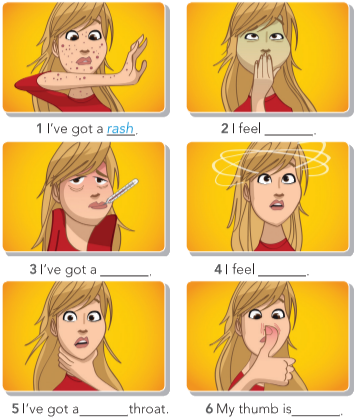Đừng bỏ lỡ những tính năng hấp dẫn của Baitap365.com
Unit 2: Get well
Tiếng Anh 11 Unit 2 2.8 Speaking
Tiếng Anh 11 Unit 2 Focus Review 2 Tiếng Anh 11 Unit 2 2.7 Writing Tiếng Anh 11 Unit 2 2.6 Use of English Tiếng Anh 11 Unit 2 2.5 Grammar Tiếng Anh 11 Unit 2 2.4 Reading Tiếng Anh 11 Unit 2 2.3 Listening Tiếng Anh 11 Unit 2 2.2 Grammar Tiếng Anh 11 Unit 2 2.1 Vocabulary Luyện tập từ vựng Unit 2 Tiếng Anh 11 English Discovery Tiếng Anh 11 English Discovery Unit 2 Từ vựngTiếng Anh 11 Unit 2 2.8 Speaking
1. Read the Symptoms section in the SPEAKING FOCUS, look at the pictures and complete the sentences. Then listen, check and repeat. 2. Complete the SPEAKING FOCUS with ONE word. 3. Cross out the options that are impossible or unlikely. 4. Choose the correct options to complete the conversation. Then listen and check. 5. In pairs, do a roleplay. Use the SPEAKING FOCUS to help you.
Bài 1
1. Read the Symptoms section in the SPEAKING FOCUS, look at the pictures and complete the sentences. Then listen, check and repeat.
(Đọc phần Triệu chứng trong phần NÓI TRỌNG TÂM, nhìn tranh và hoàn thành câu. Sau đó nghe, kiểm tra và lặp lại.)

Bài 2
2. Complete the SPEAKING FOCUS with ONE word.
(Hoàn thành TRỌNG TÂM NÓI với MỘT từ.)
|
SPEAKING FOCUS Symptoms I've got a pain in my chest/back/leg. I've got a headache / a stomach ache / a temperature / a sore throat/ a cough / a runny nose / a rash. I feel ill/dizzy/sick/ very weak. My stomach/arm/neck hurts. My ankle/thumb/toe is swollen. Diagnosis When did the pain start? I'm going to examine you / 1take your temperature. I'm going to 2______ a blood test. Breathe in and out. 3______wide. Lie down, please. I think you've got indigestion/flu / an infection / a virus. You're probably allergic to ... If I press here, does it hurt? Treatment You should eat more slowly / go on a diet. You need to drink more water. I'm going to 4______ you a prescription. I'm going to 5______ an appointment for you. 6______ one tablet after each meal. |
Bài 3
3. Cross out the options that are impossible or unlikely.
(Gạch bỏ các tùy chọn không thể hoặc không chắc chắn.)
1. Do you feel well/dizzy/temperature today?
(Hôm nay bạn có thấy khỏe/chóng mặt/nhiệt độ không?)
2. Do your knees/feet/eyebrows hurt sometimes?
(Đôi khi đầu gối/bàn chân/lông mày của bạn có bị đau không?)
3. Did you have a sore throat/ a headache/ a diet yesterday?
(Hôm qua bạn có bị đau họng/đau đầu/ăn kiêng không?)
4. Have you ever had a virus/ a hospital/ a rash?
(Bạn đã bao giờ bị nhiễm vi-rút/ bệnh viện/ phát ban chưa?)
5. What is the best thing to do if your tooth/ ankle/wrist is swollen?
(Điều tốt nhất nên làm nếu răng/mắt cá chân/cổ tay của bạn bị sưng?)
6. When was the last time you had a pain in your neck/hair/chest?
(Lần cuối cùng bạn bị đau cổ/tóc/ngực là khi nào?)
Bài 4
4. Choose the correct options to complete the conversation. Then listen and check.
(Chọn các phương án đúng để hoàn thành đoạn hội thoại. Sau đó lắng nghe và kiểm tra.)
Doctor: Hello, Andrew. What's the problem?
Andrew: I've got a 1pain/ sore in my chest.
Doctor: I see. And when did it start?
Andrew: A few days ago.
Doctor: Do you have any other 2sicknesses/symptoms?
Andrew: Yes, sometimes my stomach 3hurts/is dizzy.
Doctor: And how are you feeling now? Have you got a headache? Do you 4have / feel dizzy? Andrew: No, I feel OK. But when I have a stomach ache, I feel a bit 5sick/hurt.
Doctor: I see. And do you have this 6illness / pain all the time?
Andrew: No, I get it in the evening after dinner and sometimes after lunch.
Doctor: Aha. OK, I'm going to examine you.
Bài 5
5. In pairs, do a roleplay. Use the SPEAKING FOCUS to help you.
(Theo cặp, đóng vai. Hãy sử dụng TRỌNG TÂM NÓI để giúp bạn.)
Student A: You're a student. You are doing a language course in the UK. You fall ill and go to see a doctor. Tell the doctor your symptoms and answer any questions.
(Học sinh A: Bạn là sinh viên. Bạn đang tham gia một khóa học ngôn ngữ ở Vương quốc Anh. Bạn ngã bệnh và đi khám bác sĩ. Hãy cho bác sĩ biết các triệu chứng của bạn và trả lời bất kỳ câu hỏi nào.)
Student B: You're a doctor. Your patient is a foreign student. Find out about his / her symptoms, ask questions and give advice.
(Học sinh B: Bạn là bác sĩ. Bệnh nhân của bạn là một sinh viên nước ngoài. Tìm hiểu về các triệu chứng của anh ấy/cô ấy, đặt câu hỏi và đưa ra lời khuyên.)
Mẹo tìm đáp án nhanh
Search Google: "từ khóa + baitap365" Ví dụ: "Bài 5 trang 13 SGK Vật lí 12 baitap365